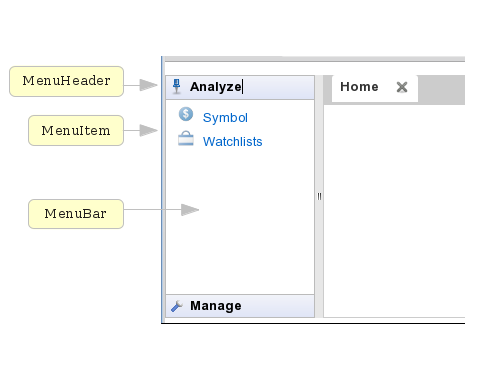Chapter 4. Menu
This Chapter covers design of Menu system used by Fins. Menu contains three widgets
MenuItem
MenuHeader
MenuBar

Figure 4.1. Menu parts
MenuHeader is a stylish header that display menu categories. MenuItem is GWT Anchor widget and the user clicks them to invoke menu options. MenuBar is a StackLayoutPanel with MenuHeader as header and MenuItem as content.
4.1. ClientBundle
MenuBar, MenuHeader and MenuItem widgets use icons for a stylish look.
GWT streamlines the image management through GWT ClientBundle, which
provides an unified way to create and manage the icons. Let’s create
FinsResources, a ClientBundle, to manage image resources used in the
application.
FinsResources
FinsResources is an interface that extends ClientBundle and define
methods to access images as ImageResource. Client code access
individual images through methods defined in the interface. With
ClientBundle, GWT packages many images as a single large image file for
download, instead of multiple smaller ones. This will improve the
application performance by reducing the number of round trip to server
to fetch images. Among other things, this feature makes Fins extremely
light on network.
To place all images, create a new package
in.fins.client.images and copy images from
sample code to this package.
Select package in.fins.client and choose File → New → Client
Bundle and in Client Bundle window, enter Name as FinsResources.
Then in Bundled Resources click Add Multiples and select
required images from in.fins.client.images package. This adds access
methods for selected images, and you may use edit option to modify
the auto generated method names.
Add following lines to FinsResources.java to make it a singleton.
in.fins.client/FinsResources.java
....
public static final FinsResources INSTANCE = GWT.create(FinsResources.class);
....
static final INSTANCE makes FinsResources as singleton to ensure that
only one instance of FinsResources exists. For any new images, edit
FinsResources directly and add access methods.
When GWT compiles the project, it packages all the images into a single large file for transmission to client. This file is hash based and it will not be downloaded again until hash is changed due addition or deletion of images.
Access images with the interface methods. For example, if FinsResources has following method
@Source("in/fins/client/images/coffee.png")
ImageResource coffee();
Access coffee.png as
// in java classes
FinsResources.INSTANCE.coffee();
// in ui.xml
<ui:with type="in.fins.client.FinsResources" field="resource" />
<g:Image imageResource="{resource.coffee}" />